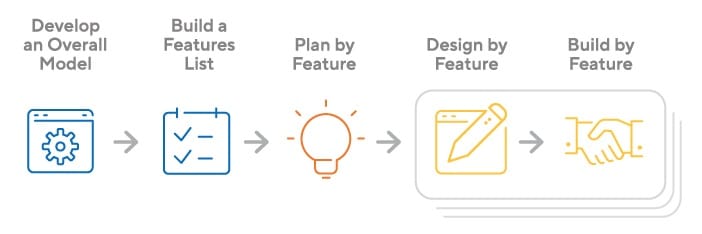There are many different approaches to software development in the UK. Each of these methods has its characteristics. Typically, any UK software development company uses one of four main methodologies, which we will discuss later in this article.
Agile Software Development Methodology
It is an iterative and incremental modern method of software development that emphasizes flexibility, collaboration, and rapid response to sudden changes. This approach was invented in the USA several years ago. 17 IT employees worked on its development, who recorded 12 principles of this method, of which it is essential to highlight the following options:
- Interaction and individuality. The main focus here is not on tools and processes but on the interaction of team members with each other. Individual communication and teamwork on the project are very important here.
- Software that works. This result is considered the most important indicator of progress. The software must be ready to use after each iteration of any process, allowing the customer to see concrete results.
- Interaction with the client. The customer here also participates in the development process. Their opinion is listened to at all stages, and changes to the work can be made at any time.
- They are responding to change, which means readiness for changes in requirements at any time, including in the final stages. Flexibility and quick response to feedback help developers quickly get used to new conditions.
Agile offers a more interactive and flexible approach than other classical variants.
Its strengths include flexibility, adaptability, a better understanding of the customer’s vision, working software after every iteration of the process, and improved collaboration with communication.
Unfortunately, this method has weaknesses, including difficulty in scaling, the threat of project failure due to uncertainty it, the need for client participation in the entire development process, and insufficient documentation.
As you can see, it is suitable for projects with changing requirements and the importance of interaction with the customer. It is also an excellent option for developing business management programs.
Waterfall Methodology
A traditional method of software development in which each stage depends on the completion of the previous one. One of the first formalized and used approaches in large projects.

It provides a strict sequence of the following steps:
- Definition of requirements. Here you will need to collect and document all the customer’s requirements for the future product;
- Design. Now comes the time to work on developing the design and architecture of the future system using the collected requirements. At this stage, detailed plans, various data structures, and algorithms are created;
- Development. Dedicated to fulfilling all requirements;
- Testing. Ready-made software is subject to several types of testing to ensure its correct operation;
- Implementation. After successful testing, the software is implemented and launched in a real environment or on real equipment;
- Supporting. At the final stage, the program is supported and updated if necessary.
Its main advantages are a structured process, complete documentation, and predictability. The main disadvantages most often include instability to changes, long development times, and verification difficulties.
The waterfall is losing its popularity due to the inability to quickly adapt to changes in modern conditions of changing market demands. However, it can still be effective in some cases, especially in projects with clear, unchanging requirements.
Feature-driven Development (FDD)

It is a method that focuses on creating specific functionality (features) in a project.
There are several main principles:
- Functionality division. The project is broken down into a set of specific functionalities, each of which is perceived as an independent project in the overall context.
- Individual features. Each functionality is perceived as an individual project with specific resources and deadlines. It allows the team to focus on specific tasks and achieve better results.
- Quality control. Here, great attention is paid to the high level of quality of each functionality. Each feature is thoroughly tested and verified to ensure it meets all requirements.
- Collective ownership. The team takes an active part in the creation of each feature, which promotes collective ownership of the project.
The advantages of FDD can be considered its functionality, flexibility, and prompt response to any changes, while most consider the main disadvantages of this method to be the difficulty of scaling and dependence on the work of the team.
It is well suited for products that require a clear definition of functionality and are ready for active team participation in their development.
Lean Software Development Methodology
A methodology very similar to the Lean Manufacturing concept that emerged in Japan in the 1950s and 1960s. It was developed specifically to optimize production processes and resource management.

The main goal of this approach is to increase efficiency by eliminating waste during software development.
It is achieved by improving processes reducing waits between jobs and increasing product quality. This method also places great emphasis on minimizing unnecessary movements and transferring information, which promotes more effective teamwork.
Its main advantages include the following features:
- High efficiency and productivity. They are attributed to process improvements and waste elimination;
- High-quality product. Thanks to the team’s desire to eliminate errors at the initial stages, a product of a higher level of quality is created that fully satisfies all client requirements;
- Flexibility and adaptability. This approach allows you to quickly respond to changes in requirements and market conditions due to its flexibility and emphasis on a continuous workflow.
The following features of this method are distinguished:
- Continuous improvement. Continuous process improvements are encouraged to improve efficiency and quality of work;
- Collective responsibility. Each team member is responsible for the overall success of the project, thereby stimulating teamwork and close collaboration;
- Workflow optimization. Focusing on improving workflow, eliminating delays, and simplifying procedures speed up turnaround times and improve productivity.
It’s this emphasis on eliminating waste and improving processes that make this method so valuable in the fickle world of software development.
Conclusions
We analyzed four main types of software development. Agile is good for agile projects with frequent requirements changes. The Waterfall is good for projects with rigid requirements and stable conditions. Feature Driven Development focuses on specific functionality, and Lean strives to reduce waste and improve efficiency.
The choice of methodology will depend on the specific requirements of the project, available resources, and the strengths of the development team. We hope you will be able to choose the most suitable option for yourself.

